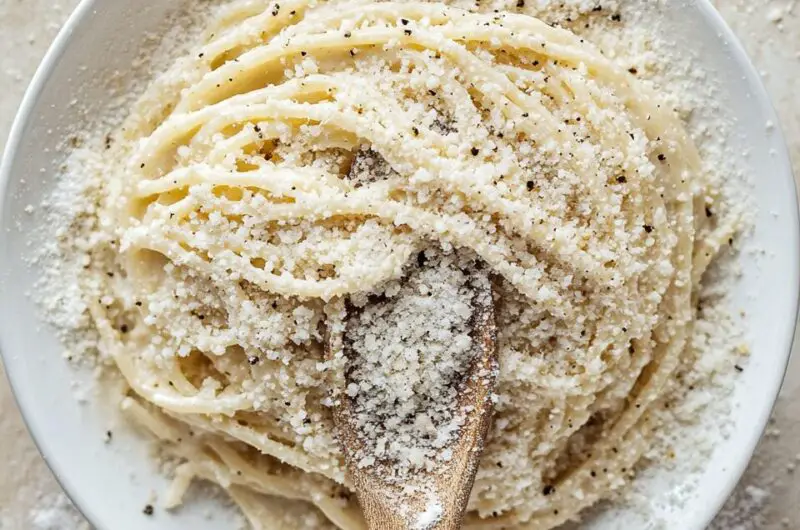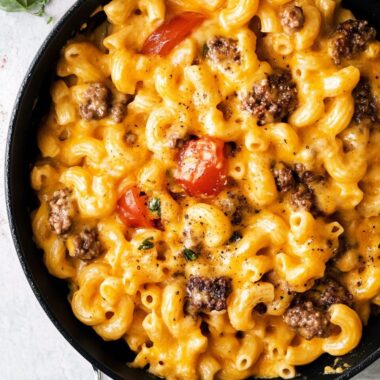Cacio e Pepe, translating to ‘cheese and pepper,’ is a cornerstone of Roman cuisine that showcases the beauty of simplicity. This dish combines al dente pasta with a creamy sauce made from Pecorino Romano and freshly cracked black pepper, resulting in a harmonious blend of flavors that’s both comforting and indulgent. The magic of Cacio e Pepe lies in its minimalism using just a handful of quality ingredients to create a dish that’s rich in taste and texture. Perfect for a quick weeknight dinner or a sophisticated meal, this recipe is a testament to the idea that less is often more in the culinary world.
Full Recipe:
Ingredients:
- 1 pound pasta (such as Nodi Marini, spaghetti, or bucatini)
- 3 tablespoons unsalted butter
- 1 teaspoon freshly ground black pepper
- 1 cup freshly grated Parmesan cheese
- 1 cup freshly grated Pecorino Romano cheese
- Salt, to taste
Directions:
- Bring a large pot of salted water to a rolling boil over high heat. Cook the pasta until just shy of al dente, about 8 minutes. Reserve at least 1½ cups of the pasta water before draining.
- While the pasta cooks, melt the butter in a large skillet over medium heat, stirring occasionally until fully melted and smooth.
- Add the freshly ground black pepper to the melted butter, stirring frequently until the pepper becomes aromatic and slightly toasted.
- Pour in ½ cup of the reserved pasta water into the skillet, stirring well to combine with the butter and pepper mixture.
- Toss the drained pasta into the skillet, ensuring it’s evenly coated with the butter and pepper mixture. Turn off the heat.
- Gradually sprinkle in the Parmesan and Pecorino cheeses, adding another ½ cup of pasta water as you mix to create a creamy sauce that coats the pasta.
- Stir the pasta continuously, adding more pasta water as needed to maintain a light, creamy consistency. Serve immediately, topping with extra grated cheese if desired.
Prep Time: 10 minutes | Cooking Time: 15 minutes | Total Time: 25 minutes
Kcal: Approximately 450 kcal per serving | Servings: 4
The History of Cacio e Pepe
The origins of Cacio e Pepe date back to ancient Rome, where it was a staple for shepherds who needed simple, non-perishable food that was easy to carry during long journeys. Pecorino Romano cheese, a key component of the dish, was ideal for this purpose due to its long shelf life and robust flavor. Black pepper, though once a luxury, became more accessible and added warmth to the otherwise simple pasta.
Over centuries, Cacio e Pepe evolved from a humble shepherd’s meal to a beloved dish found in trattorias and fine dining establishments across Rome. Its enduring popularity lies in its straightforward preparation and the magical transformation of simple ingredients into a creamy, velvety sauce that coats every strand of pasta.
Why Cacio e Pepe Stands Out
One of the defining characteristics of Cacio e Pepe is its minimalism. Unlike other pasta dishes that rely on heavy sauces or a long list of ingredients, Cacio e Pepe emphasizes purity and technique. The dish relies on the careful emulsification of cheese, pasta water, and pepper to create a creamy sauce without the use of cream or butter. This delicate balance of flavors and textures makes every bite a perfect combination of richness and spice.
Another reason for the dish’s popularity is its versatility. While traditionally made with spaghetti or tonnarelli (a square-cut pasta similar to spaghetti), Cacio e Pepe can be adapted to various pasta shapes, such as bucatini, fettuccine, or even short pasta like rigatoni. Additionally, home cooks can experiment with different cheese blends, although Pecorino Romano remains the authentic choice for its sharp, tangy profile.
Tips for Perfecting Cacio e Pepe
Mastering Cacio e Pepe may seem simple, but it requires attention to detail and technique. The key to achieving a smooth, creamy sauce is to reserve and use the starchy pasta water effectively. This water helps bind the cheese and pepper into a velvety emulsion, coating the pasta evenly.
Using freshly grated Pecorino Romano cheese is also essential. Pre-grated cheese often contains anti-caking agents that prevent proper melting. For the pepper, freshly grinding whole peppercorns enhances the dish with aromatic heat and depth.
Temperature control is another crucial factor. Adding cheese to overly hot pasta can cause it to clump rather than melt smoothly. By turning off the heat and allowing the pasta to cool slightly before incorporating the cheese, you can achieve a silky, lump-free sauce.
Variations and Modern Twists
While purists may argue that Cacio e Pepe should remain untouched, modern interpretations of the dish have introduced creative variations. Some chefs incorporate butter for extra richness or use a blend of Pecorino Romano and Parmesan to balance the flavors. Others add seasonal vegetables like asparagus or peas for added freshness and color.
For those looking to elevate the dish further, truffle shavings or truffle oil can add a luxurious aroma. Additionally, swapping traditional pasta for gluten-free alternatives or zucchini noodles allows those with dietary restrictions to enjoy the iconic flavors of Cacio e Pepe.
Pairing Cacio e Pepe with Wine and Sides
Cacio e Pepe pairs wonderfully with crisp, dry white wines that cut through the dish’s richness. Italian wines like Vermentino, Greco di Tufo, or a light Frascati complement the savory cheese and pepper notes. For red wine enthusiasts, a light-bodied Chianti or Barbera provides a delightful contrast.
When it comes to side dishes, a simple arugula salad dressed with lemon and olive oil balances the pasta’s indulgence. Roasted vegetables, such as zucchini or bell peppers, also offer a fresh and colorful accompaniment. A slice of crusty Italian bread is perfect for soaking up any remaining sauce.
Why Cacio e Pepe is a Timeless Classic
Cacio e Pepe’s enduring appeal lies in its simplicity and depth of flavor. It represents the essence of Roman cuisine honest, unpretentious, and incredibly satisfying. The dish celebrates high-quality ingredients and traditional techniques, offering a culinary experience that transcends trends and fads.
For home cooks, Cacio e Pepe is a reminder that extraordinary meals do not require complicated recipes or elaborate preparations. With just a few pantry staples and a bit of finesse, anyone can recreate this timeless Roman classic in their own kitchen.
Conclusion:
In a world where culinary trends come and go, Cacio e Pepe remains a beloved and timeless dish. Its origins as a humble shepherd’s meal speak to the power of simple, high-quality ingredients prepared with care. The creamy, peppery pasta continues to captivate food lovers worldwide, from casual home cooks to Michelin-starred chefs.
Whether you stick to the classic recipe or add your own creative twist, Cacio e Pepe is a testament to the beauty of Italian cuisine. It offers a delicious reminder that sometimes, the simplest dishes bring the most pleasure to the table. With its rich history and unparalleled flavor, Cacio e Pepe will undoubtedly remain a favorite for generations to come.








